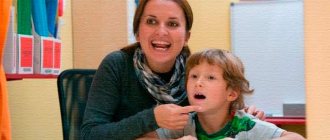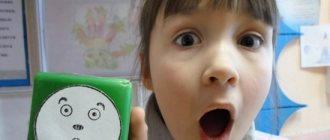Practice using the information block for parents on lexical topics.
The problem of organizing correctional work to overcome speech impairment in preschool children (5-6 years old) with such a type of speech pathology as underdevelopment of the lexico-grammatical structure is relevant, in our opinion, because lexico-grammatical operations for generating speech are extremely complex and involve a fairly high level of development of analytical and synthetic activities.
To increase the effectiveness of correctional influence, we consider the need for integrated work in the interaction of all subjects of educational activity: speech therapists, educators, parents, physical education instructor, music director, art teacher.
An integrated approach to overcoming a speech defect involves the active participation of parents, who consolidate all the speech skills and abilities of children acquired in kindergarten in everyday life.
The purpose of the pedagogical experience: to create in kindergarten the necessary information block of complex correctional work to overcome lexical and grammatical speech disorders in preschool children (5-6 years old).
This system of work has been used in the work of speech therapists at the MADOU “Kindergarten No. 395” of the city of Perm A. F. Buzmakova, E. G. Bugrova for 15 years, has a positive expert opinion from Art. Researcher at the Laboratory of Special Education of PKIPKRO E. E. Ayupova.
Material for the design of the “Speech therapist advises” stand
The child will have to master the entire system of knowledge through oral and written speech. COMPONENTS OF SPEECH must be formed in children by the beginning of school :
1. ABILITY TO LISTEN AND HEAR OTHERS.
If such a skill has not been developed, the child may have difficulties in mastering the material that is presented orally by the teacher. Such a child has difficulty communicating with peers and does not control his behavior.
2. SOUND SIDE OF SPEECH.
Correct pronunciation and clear distinction of sounds by ear are necessary conditions for mastering writing and reading. The child must not only be able to clearly pronounce complex words (for example: motorcyclist, traffic controller), but also be able to speak loudly or quietly, faster or slower. A letter is a reflection of a child’s oral speech. Violations in this area lead to errors in writing due to reliance on incorrect pronunciation.
3. FUNCTIONS OF LANGUAGE ANALYSIS.
To write correctly, children must be able to: divide sentences into words; divide words into syllables; be able to identify all the sounds in words and identify them. Errors in language analysis appear in writing in the distortion of words and sentences (omission of letters, rearrangements, etc.)
4 .
LEXICAL ASPECT OF SPEECH (VOCABULARY).
Children should be able to accurately select words, use complex words (for example: long-legged), use phrases with a figurative meaning (for example: headlong), select synonyms (for example: brave - courageous - courageous). Poor vocabulary affects reading comprehension, even when reading is technically correct. In the future, errors may occur in the selection of test words in the letter.
5. GRAMMATICAL ASPECT OF SPEECH.
To write correctly, children must be able to change words and form new ones, understand and use prepositions correctly, otherwise mistakes in endings, omissions or substitutions of prepositions may occur (over the table - “on the table”, went to the forest - “went to the forest”). There may be difficulties in composing sentences, omissions of sentence members, etc.
6. CONNECTED SPEECH.
Children should be able to communicate freely with adults and peers, talk about experienced events, retell fairy tales, and describe objects. Violation of independent coherent speech can cause difficulties in retelling or composing a story, writing essays and presentations.
To PROVIDE HELP
to students with such speech disorders, timely speech correction and preventive work to prevent reading and writing disorders are necessary. For this purpose, our school employs speech therapists who conduct special correctional classes. During speech therapy classes, the child develops a short-term skill of correct speech, which must be controlled by all adults surrounding the child and consolidated in various types of activities. Thanks to the joint work of a speech therapist, educational psychologist, teachers and parents, it is possible to promptly and efficiently help children overcome speech impairments, successfully master the Russian language and reading program, and form a positive attitude towards learning.
The role of the speech therapy corner
In the context of the educational concept of modern preschool educational institutions (DOU), classes for the correction and development of speech can be conducted in two options:
- in a specially equipped room for classes with a speech therapist;
- in each kindergarten group.
In the first case, all equipment for work is located in the specialist’s office. The location of basic materials for group work is due to the fact that in kindergarten the speech therapist does not have an office or the teacher himself is engaged in correctional work. A speech therapy corner is part of a subject-development environment for games individually or in a group, aimed at correcting existing speech disorders and stimulating the speech activity of children. The role of the speech therapy center is to:
- enriching the emotional and practical experience of establishing contact between a child and peers, adults (for games, completing tasks in a group, children need communication, that is, work in the speech corner stimulates the development of oral speech and communication skills);
Working in a speech corner also helps children learn to interact with each other
- involving children in cognitive activity (thanks to the varied content of the corner, children have the opportunity to work with materials that seem interesting to them at this stage of development);
- stimulation of initiative (children look at manuals in the corner with great pleasure, play with toys, coming up with new ways to interact with them).
Goals and objectives of creating the center
The content of the speech therapy corner is based on lexical topics, considered in accordance with calendar and thematic planning. In addition, the correction center materials must be related to:
- the program according to which the preschool educational institution and a specific group operates (for example, if a kindergarten has speech therapy groups, then the subject-development zone will not only be larger in terms of space occupied, but also more diverse in content);
- physiological and psychological-pedagogical features of speech development at a specific age (for example, in the junior and middle groups, the work takes into account the order of mastering sounds - a, o, e, p, m, b c 1.5–2 years, i, s , y, f, v, t, d, n, k, g, x, j at 2–4 years).
Thus, the goals of creating a speech corner in a preschool educational institution are:
- fine motor skills training for the full and timely development of coherent, conscious speech with the help of special simulators (laces, tops, etc.);
- stimulation of the speech apparatus to pronounce consonant sounds that differ in the location of the obstacle that the air flow encounters (especially the anterior lingual palatal sounds w, zh, r, h and anterior lingual dental sounds l, z, s);
- mastering the skill of correct inhalation and exhalation during the speech act with the help of breathing exercises (important for pronouncing consonants that require a certain direction of air flow to the place of the obstacle);
Developing proper breathing is one of the main areas of speech development
- development of logical thinking, attention, ability to find cause-and-effect relationships;
- practicing sound pronunciation (when learning pure tongue twisters and tongue twisters);
- development of phonemic hearing (children understand the meaning of words from poems, fairy tales, perceived by ear);
- mastering the principles of the grammatical structure of language in games (for example, the formation of diminutive forms of nouns using the suffixes -chka-, -onk-, etc., as well as the study of syntactic norms, in particular, the rules for constructing sentences).
This is interesting. The acoustic realization of consonant sounds is possible due to the fact that when they are pronounced, the vocal tract narrows, causing complete or partial blockage of the air flow. Changing the direction of the latter makes it possible to produce different consonant sounds. To pronounce vowels, there is no significant narrowing of the vocal tract.
At the same time, for each age, the set goals are implemented within the framework of solving specific tasks, which are cumulative in nature, that is, they are supplemented and enriched from year to year.
Work on speech development is built consistently from year to year
Table: tasks for creating a speech corner for different ages
| Group | Tasks |
| First youngest | Overcoming speech negativism (when children strive to show, rather than say, a word or phenomenon) in paired and group games. An exercise in matching an object with an image in a picture. Clarification and enrichment of the dictionary. Cultivating attention to addressed speech. |
| Second youngest | Enrichment and activation of the vocabulary on program lexical topics (by filling the speech therapy area with suitable pictures). Development of dialogic speech (in play situations when interacting with dolls and toys). Development of speech breathing and the ability to coordinate speech with movement (thanks to a selection of breathing exercises). Development of auditory and visual attention during the game. Development of fine and gross motor skills of children when working with simulators. |
| Average | Activation and enrichment of passive and active vocabulary. Mastering the norms of word formation of forms of nouns and adjectives. Work on the ability to control the force and duration of exhalation. Fine and gross motor skills training. Development of spatial concepts. |
| Senior, preparatory | Practicing and consolidating lexical material, lexical and grammatical categories. Formation of phonemic perception and hearing (distinguishing between soft and hard sounds, for example). Development of articulatory motor skills. Consolidating the skills of correct sound pronunciation of given sounds in isolation, in syllables, words, in sentences, in coherent speech (by involving children in role-playing games). Activation of vocabulary, generalizing concepts and lexical and grammatical categories. Development of coherent speech. |
Design of a speech therapy room “Speech therapy tricks”
Municipal Preschool Educational Institution
Shatlova Svetlana Sergeevna
Teacher-speech therapist of the 1st qualification category
The office of a kindergarten teacher-speech therapist plays a special role as a room where children play with great pleasure. The game allows you to naturally, subtly and unobtrusively eliminate speech deficiencies, makes it possible to repeatedly repeat difficult speech therapy exercises, and master literacy. Speech activity is formed, educated, and developed in it. Speech therapists working in kindergartens have long begun to create new types of equipment, develop speech games and aids, and change the developmental environment of classrooms. I invite my colleagues to get acquainted with my ideas for its design and equipment. I have made a number of visual wall aids that help me teach literacy to preschool children with general speech underdevelopment.
Literacy learning is a purposeful, systematic process to prepare for mastery of writing and reading. My handmade manuals help me get acquainted with and remember sounds and letters. These aids are made of isolon mats with plastic pockets for letters and pictures in the form of different figures and animals: a caterpillar, Leopold the cat, colorful cars, colorful castles.
N
and the first stage of learning to read and write involves familiarization with vowel sounds and letters. The “Caterpillar” manual helps us with this. On each circle of the body is placed the letter with which the children became acquainted. And a sound is attached here with an image of the articulation of the corresponding sound. Children easily remember how a sound is pronounced and a letter looks like.
Stage II – familiarization with consonant sounds and letters. When getting acquainted with each sound, its characteristics are given: a consonant can be hard and soft, and it is immediately explained that a green sound sign means softness, a blue sign means hardness. Here we designate the symbol of sound - a letter. “Leopold the Cat” helps us with this.
To determine and consolidate the hardness and softness of consonant sounds, children are offered the “Machines” manual in different colors of blue and green. My children and I determine the hardness or softness of the initial (maybe middle or last) sound of objects from pictures and ride them on the appropriate car. For example: the picture shows a tray. The child analyzes the first sound “P”, it is a consonant, hard sound, we place it in a blue car. And he places a card with the letter P in the cabin, and “puts” a picture with a tray in the back of the car. These machines help children remember color symbols for sound-letter analysis.
And finally, to consolidate knowledge of letters and sounds, a caterpillar with vowels and cars with consonants come to the “City of Letters”, where there are only 3 castles: red, blue and green. The caterpillar puts all its vowels in the red castle, the blue car puts its consonants in the blue castle, the green car puts it in the green castle. This city serves as a small hint for children in further work with letters and sounds.
These are the speech therapy tricks I have in my office.
Source











